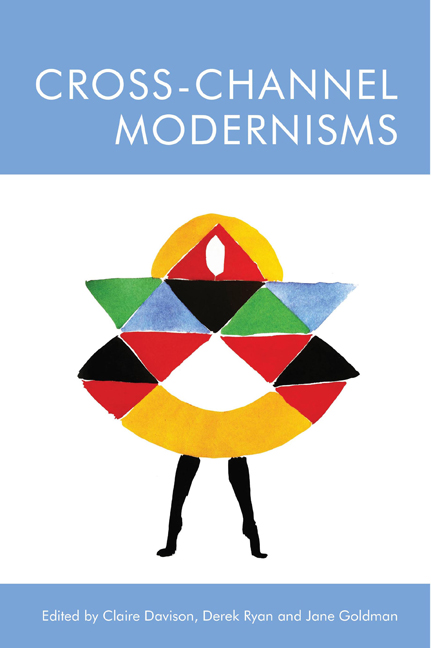Book contents
- Frontmatter
- Contents
- List of Figures
- Notes on Contributors
- Introduction: Cross-Channel (Transmanche) Modernisms
- Interlude: Translating
- 1 On Unknowing French? Rhythm and Le Rythme on a Cross-Channel Exchange
- 2 Impressions of Translation: Ford Madox Ford’s Cosmopolitan Literary Crossings
- 3 Sydney Schiff and Marcel Proust: Table-talk, Tribute, Translation
- Interlude: Fashioning
- 4 Cross-Channel Modernisms and the Vicissitudes of a Laughing Torso: Nina Hamnett, Artist, Bohemian and Writer in London and Paris
- 5 Jean Rhys’s comédie anglaise
- 6 Betray to Become: Departure in James Joyce’s A Portrait of the Artist as a Young Man
- Interlude: Mediating
- 7 Close Up and Cross-Channel Cinema Culture
- 8 Debussy at the Omega Workshops
- 9 Across the Other Channel: Elizabeth Bowen and Modernist Mediation
- Coda: ‘You, who cross the Channel’: Virginia Woolf, Departures and the Spectro-Aesthetics of Modernism 215
- Index
Interlude: Fashioning
Published online by Cambridge University Press: 03 October 2020
- Frontmatter
- Contents
- List of Figures
- Notes on Contributors
- Introduction: Cross-Channel (Transmanche) Modernisms
- Interlude: Translating
- 1 On Unknowing French? Rhythm and Le Rythme on a Cross-Channel Exchange
- 2 Impressions of Translation: Ford Madox Ford’s Cosmopolitan Literary Crossings
- 3 Sydney Schiff and Marcel Proust: Table-talk, Tribute, Translation
- Interlude: Fashioning
- 4 Cross-Channel Modernisms and the Vicissitudes of a Laughing Torso: Nina Hamnett, Artist, Bohemian and Writer in London and Paris
- 5 Jean Rhys’s comédie anglaise
- 6 Betray to Become: Departure in James Joyce’s A Portrait of the Artist as a Young Man
- Interlude: Mediating
- 7 Close Up and Cross-Channel Cinema Culture
- 8 Debussy at the Omega Workshops
- 9 Across the Other Channel: Elizabeth Bowen and Modernist Mediation
- Coda: ‘You, who cross the Channel’: Virginia Woolf, Departures and the Spectro-Aesthetics of Modernism 215
- Index
Summary
The language of fashion is a Channel-crossing adventure in itself, which begins in the life of words as they dart back and forth, ferrying new meanings en route, losing part of the etymological body they started out with, and picking up new accoutrements along the way. Think of the word ‘fashion’ derived from the old French ‘façon’ meaning craft, workmanship, especially in the field or workshop. The sense lingers on in the English verb ‘to fashion’ and in its French counterpart ‘façonner’; the noun ‘fashion’, like the adjective ‘fashionable’, on the other hand, are translated ‘mode’, ‘à la mode’ – indeed the idiom also works well in English, so long as it is pronounced with a slight French accent. The same is true of the term ‘haute couture’ – the guarantee of style, taste and expertise either side of the Channel; in French, however, the word still flaunts its temporal inflections in a way it doesn't in English – ‘couture’ (‘sewing’) bespeaks the essential craftsmanship of the garment; it exposes the seams and threads with which those first seamstresses (‘couturières’) at the Court of Versailles first earned their own guild in 1675 (see Levron 1965: 162–5; Steele 1998: 17). The French ‘mode’, meanwhile, provides the etymological blueprint of the English ‘model’, the cat-walking, style-displaying, time-crafted (since the aesthetics of the body is a matter of fashion) body; the French for ‘model’, however, is ‘mannequin’, a word which, left untouched on the other side of the Channel, serves merely to denote the dressmaker's dummy, that straw-filled torso upon which fabric is pinned and trimmed, and selvedges are tacked. ‘Selvedges’ is another word that tells a story, but a Germanic one this time, while the French term for seams and selvedge is ‘ourlet’, derived from the Latin ‘orulare’, or border – terms that never really crossed the Channel at all. Meanwhile, by betraying philological truth and ceding to the temptation of etymological fantasy, it is tempting to hear a complex plural of ‘self’ echoing in the English ‘selvedges’, as if performing the very plurality of selves and surfaces which the world of fashion, and the ever-reflecting ricochet of mirror images that fuel it, holds up to the consumer. Might there be some subtler truth lurking beneath the surface of the Italian dictum ‘traduttore, traditore’ (‘translator, traitor’)?
- Type
- Chapter
- Information
- Cross-Channel Modernisms , pp. 91 - 95Publisher: Edinburgh University PressPrint publication year: 2020

